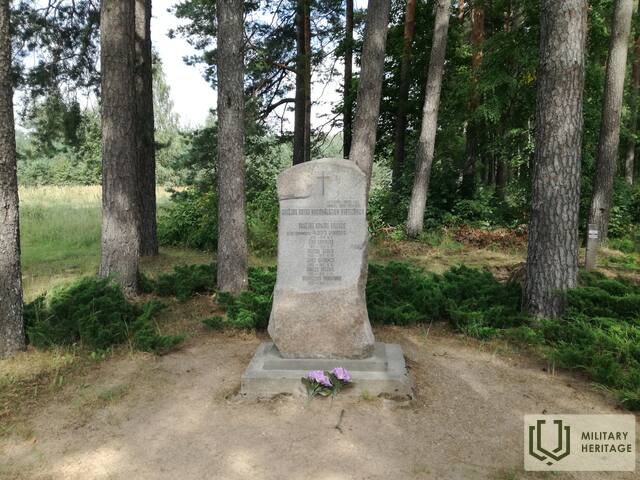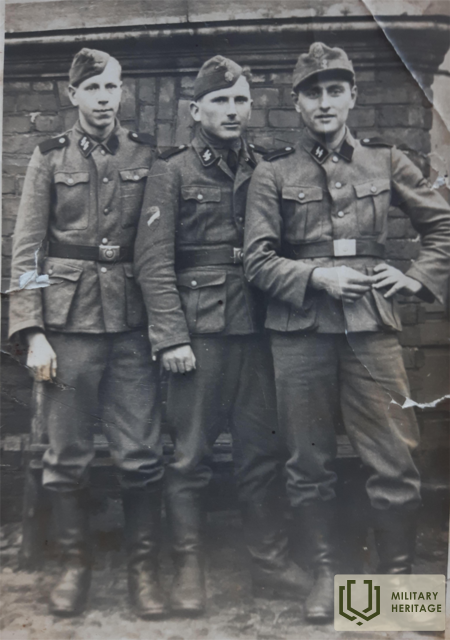Monument to the National Partisans of Susėja
Memorial site


 159
159



The Susēja national partisan unit was formed from smaller fragmented forest brotherhood groups, because initially there was no leader who could unite them. For a short time, Artūrs Grābeklis tried to coordinate the activities of the Susēja partisans, and later Markejs Gorovņovs, who fell in the winter of 1945. The Susēja national partisan unit was strengthened after the former legionnaire Alberts Kaminskis arrived in Courland, Sēlija, after the general capitulation of Germany. He established stricter discipline and united smaller groups for a joint fight against the Soviet occupation power. Cooperation was also established with forest brotherhood groups from nearby parishes and areas, especially with the Gārsene group and Lithuanian partisans who had settled on the border of Lithuania and Latvia.
In the early stages of the armed movement, it is clear that the Forest Brothers were not prepared for attacks, unable to occupy either the Kaunacki farmstead or break into the building of the Susėja executive committee. The partisans suffered losses and were unable to resist the Cheka troops for a long time, and the main method of fighting was to think about retreating in time. There was also a problem with the supply of the partisans. Despite the existing difficulties, the Susėja national partisan unit was still able to actively resist the Soviet occupation power in the first post-war years. This partisan group ceased to exist after the fall of its commander A. Kaminskis on May 14, 1946. This was also followed by the legalization of several Forest Brothers, as well as joining other partisan groups.
The monument to the national partisans of the Susēja company was opened on November 11, 1997, at the initiative of Gunārs Blūzmas, a researcher of the history of the national partisans of Sēlija. Next to the names of the fallen Susēja national partisans, a text is carved into a roughly worked boulder under the sign of a cross: “On the head of a hedgehog, I ordered you to protect your father’s land.” The monument mentions those who fell in the attack on the Susēja executive committee on July 16, 1945 - Jānis Grābeklis (1923-1945), Ādolfs Rācenis (1919-1945), Broņislavs-Arvīds Bīriņš (1919-1945) and Edgars Ērglis (1920-1945), and later the names of the murdered Līna Kaminska (1917-1945) and Albert Kaminskas (1920-1946) were added. The monument is missing the names of Arnolds Dombrovskis (1923-1945) and other national partisans who were active in the Susēja national partisan groups and who fell in 1945-1946.
Used sources and references:
H. Bruņinieks. Cheating Death. Riga: Latvian Media, 2022, pp. 79-94, 129.
https://karavirukapi.blogspot.com/2022/02/aknistes-pagasta-pieminas-akmens.html
Related timeline
Related stories
Selija's forest brother settlement in the Sūpe swamp
The Sūpes swamp is associated with the sites of national partisan settlements and battles, which were formed through the interaction of people and places. It is described in the ballad of the exiled Latvian writer Alberts Eglītis about the events in his native Sūpes swamp “In Moss and Mud” - a tribute to the Sūpes swamp partisans:
… “In 1945, as autumn glowed in the swamp -
On Pokļevinskis' birthday, Lieljānis shares at dinner:
Beer fermented in willows,
The Romulans worship butter,
I dry my mother's caraway bread,
Dried ham in March cuts,
And Stuchka's onions,
Ildzeniece cheese.
Rooms in resinous walls
And lightning has struck hearts,
And in eleven souls languish-
"The roots that have rotted in the ground..."
This interpretation of the past, with its post-World War II events, included human testimonies, expressions of spirit, and value systems. It recalls the popular support for the national partisans, whom the occupying power could not defeat so easily.






